How to design a sloping garden – key points when planning a sloped site
Experts advise on how to design a sloping garden and the main elements to include to create breathtaking spaces


There are myriad options for how to design a sloping garden that make the most of a backyard on a gradient. Far from presenting limitations, you can use inclines to your advantage as a sloping backyard offers fabulous layout and planting options that would not be possible to achieve on a flat site.
With variable levels, you can create distinct garden areas, each with their own purpose, ambiance and planting scheme, as well as a variety of seating areas in which to sit and drink in the views below or above.
Budget is important when designing any garden, but particularly so with sloping garden ideas, where if you don't plan things out carefully costs can escalate.
There are a number of key elements to consider when planning a design for a sloping garden that can also link in to other backyard ideas.
How to design a sloping garden – make it work with the natural topography of your backyard
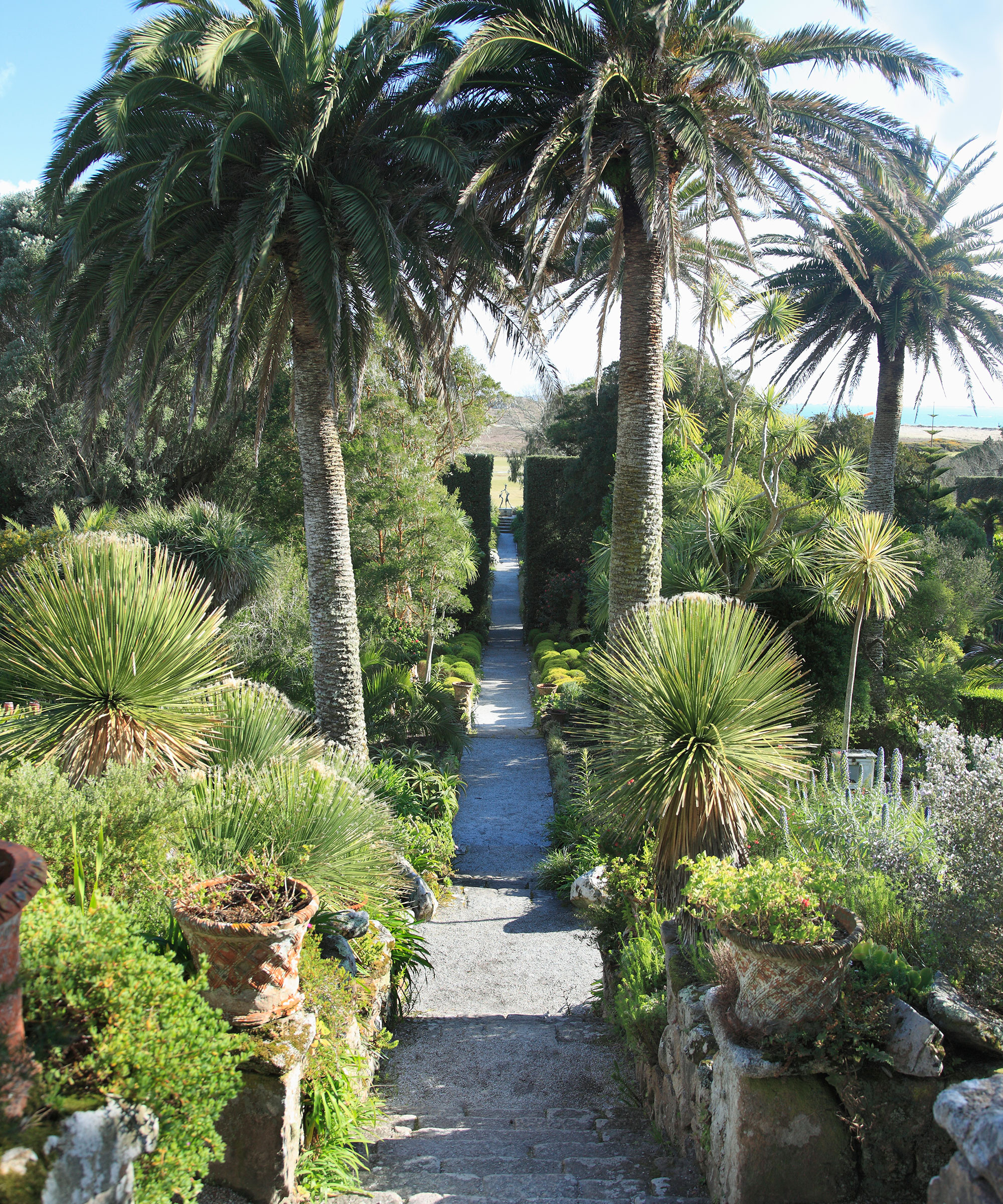
Plan the designs for a sloping garden to fit the lie of the land, and work with the natural topography of your backyard.
‘A sloping garden presents unique design opportunities to create either drama or subtlety. Finding the route through the slope is just as important as the overall effect,’ explains John Wyer, CEO and lead garden designer at Bowles & Wyer.
Incorporate pathways running along the slope, linking sets of steps or terraces. 'This offers a delightful and ever-changing perspective of the garden, as well as multiple opportunities to get your nose in the flowers!' adds John Wyer.
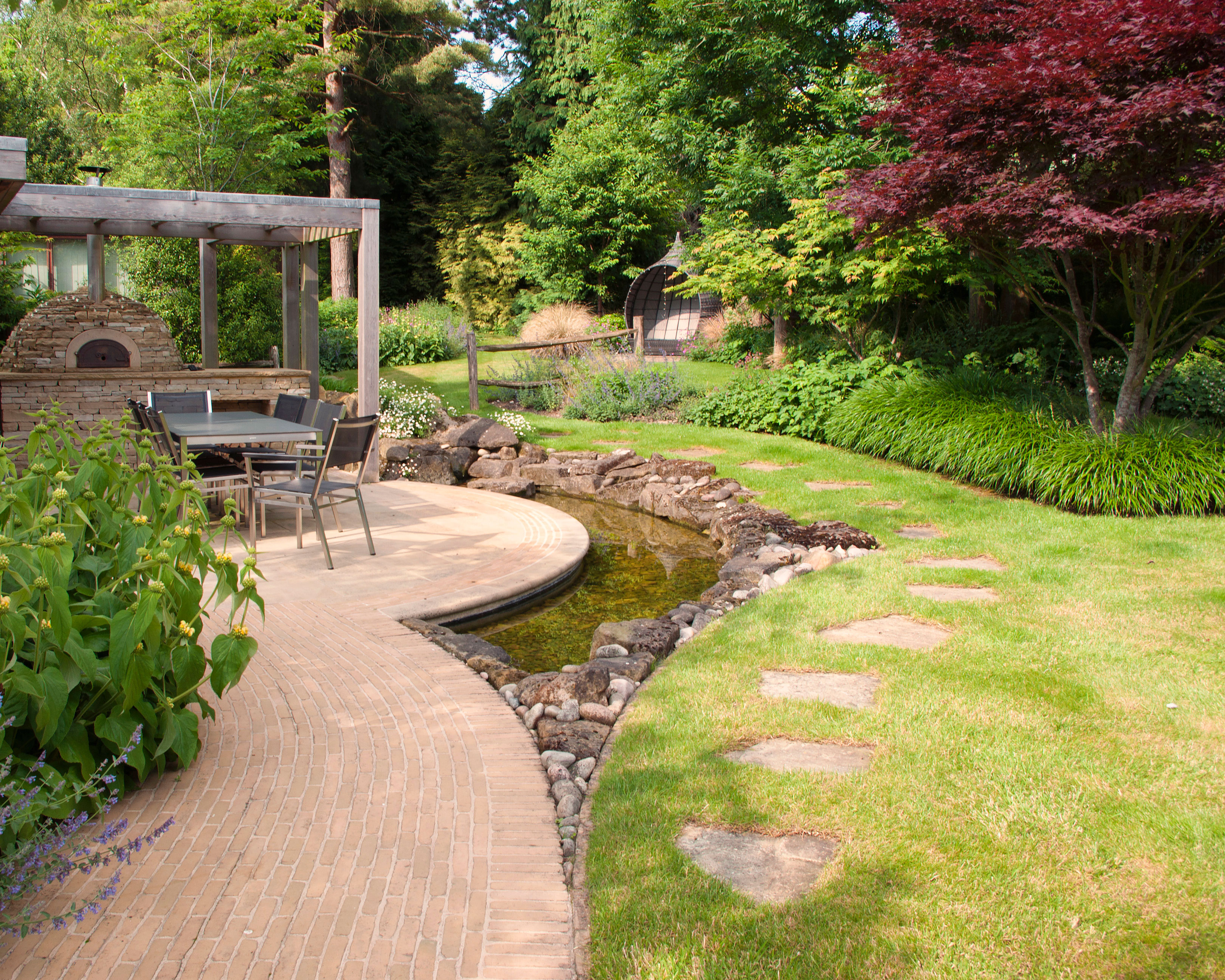
How do you plan a sloping garden?
‘Don’t be in a rush to flatten the ground in designs for a sloping garden, as changing levels offers so much potential,’ explains garden designer Helen Elks-Smith .
'If you are lucky enough to have a site with gentle undulations, following natural contours or tweaking existing ones is a wonderful way to add visual interest and interesting walks around the garden. Simple grass banks can also be utilized to retain sloping soil,’ Helen adds.
However, in tackling a steep site you do need to call on the expertise of the professionals.
'You will inevitably need a structural engineer’s input, as there will be a lot of soil to retain. Subtle, discreet terracing may also need to be designed and incorporated by an experienced landscaper,' explains garden designer Sara Jane Rothwell.
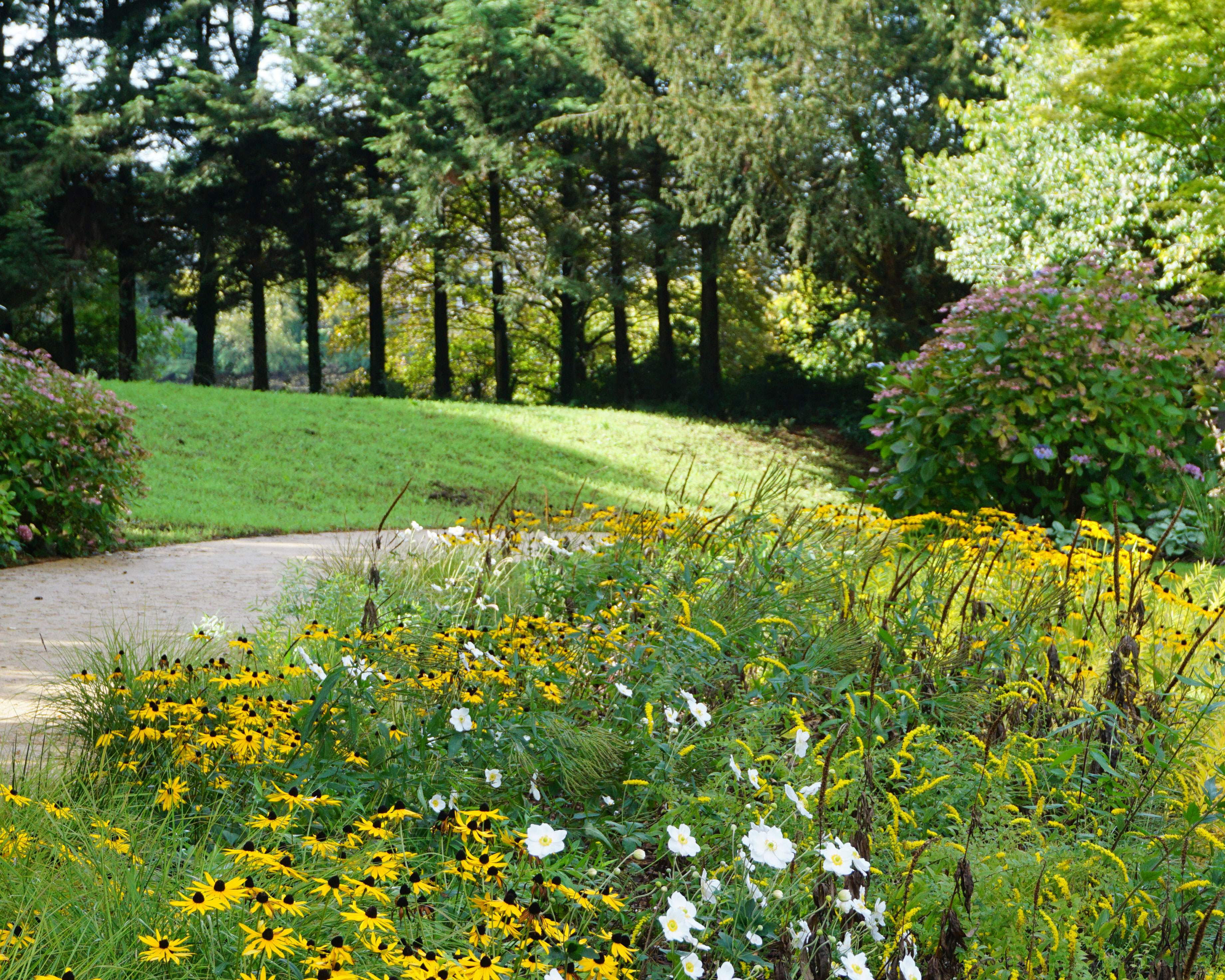
This is where a mix of patio ideas and deck ideas can be worked into your design to create the perfect layout.
'It's usually a question of planning different levels in places that are right for the location and aspect of your garden,' says says garden designer and writer Ruth Chivers, and co-author of Designing Gardens on Slopes.
'For example, creating a level paved area to sit out on is an essential, but whether you want this to be in full sun at a certain time of day will affect where you decide to make the terrace or patio.
'Views from inside your house out to the garden are as important as views from within the garden and beyond it,' she adds.
How can staircases become a feature of a sloping garden?
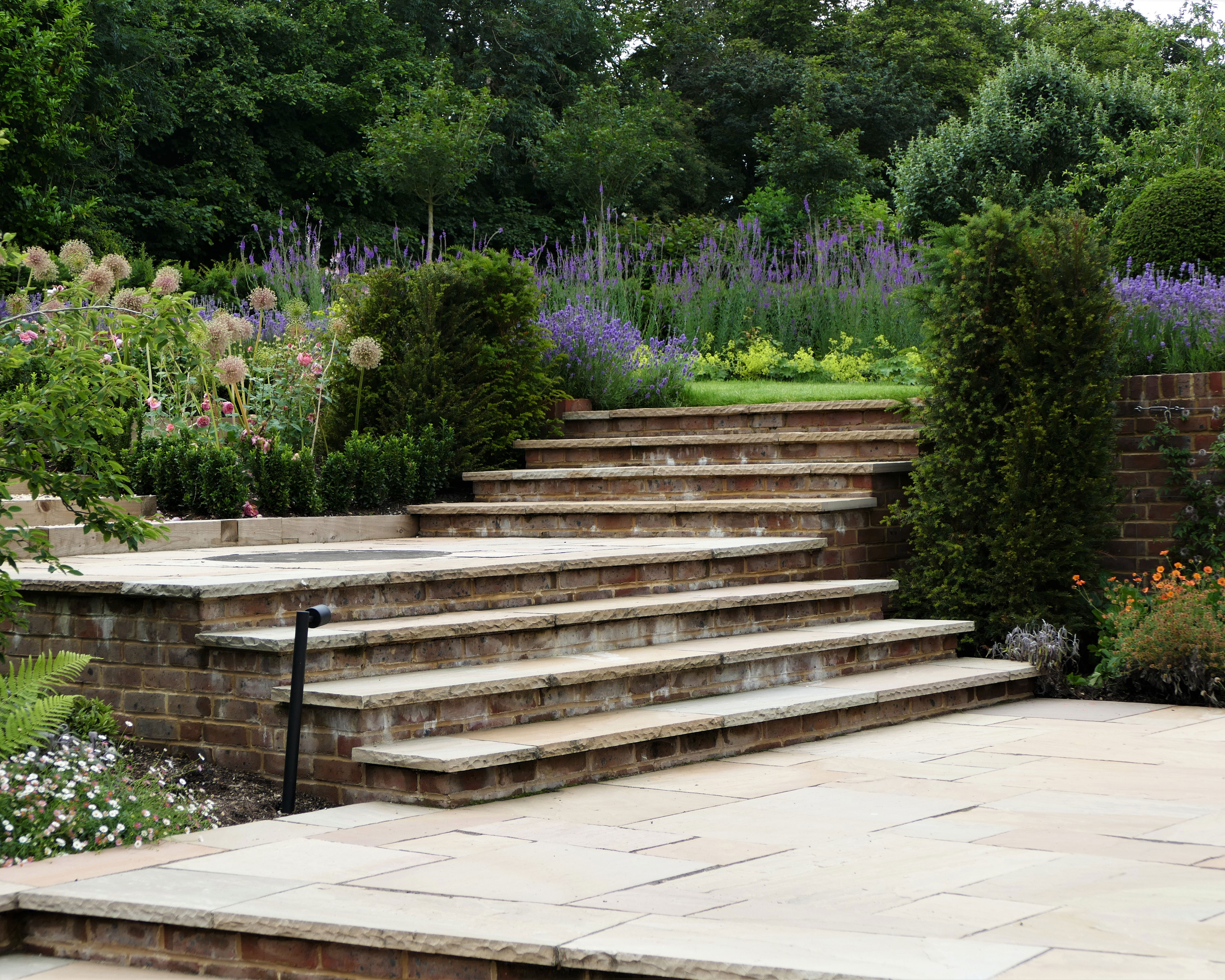
Rather than using more traditional terracing, use staircases to link levels of the back yard to become a feature in their own right in designs for a sloping garden.
‘Think of the grand staircases and terraces in Italian renaissance gardens. While we might not be able to replicate that scale and grandeur in our gardens, we can take inspiration from their designs,’ says John Wyer.
You can make a statement with sweeping sets of steps leading up to an upper level, possibly a seating area, bench, or even a piece of sculpture.
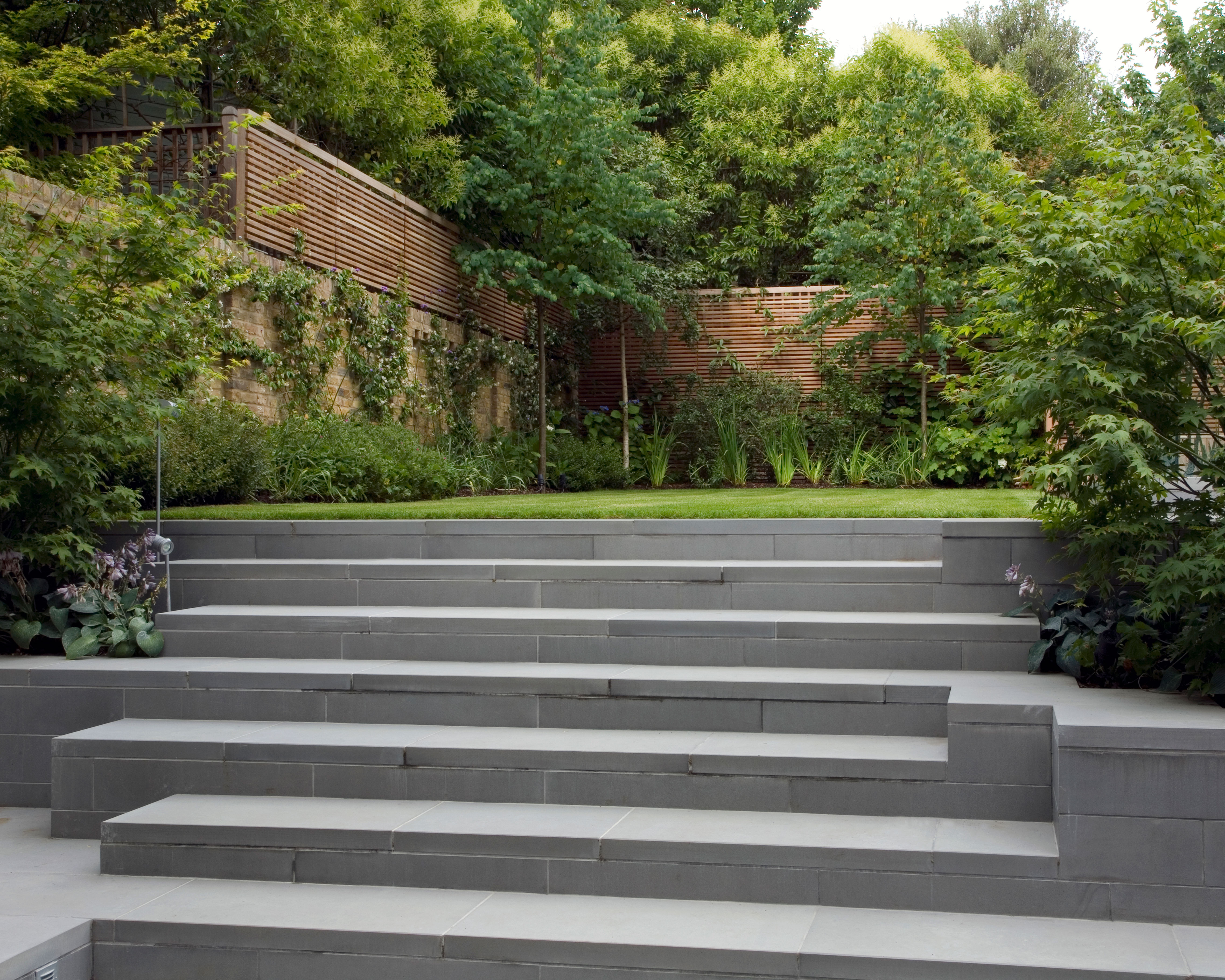
If you are designing for a traditional space you may want to use a stone that blends with and is complementary to the house.
But for a modern take on a traditional staircase, think outside the box when it comes to materials to use for the steps.
Consider how a material that contrasts with the surrounding greenery, such as contemporary grey stone, can make more of an impact, 'with staggered step lengths creating interest,' adds John.
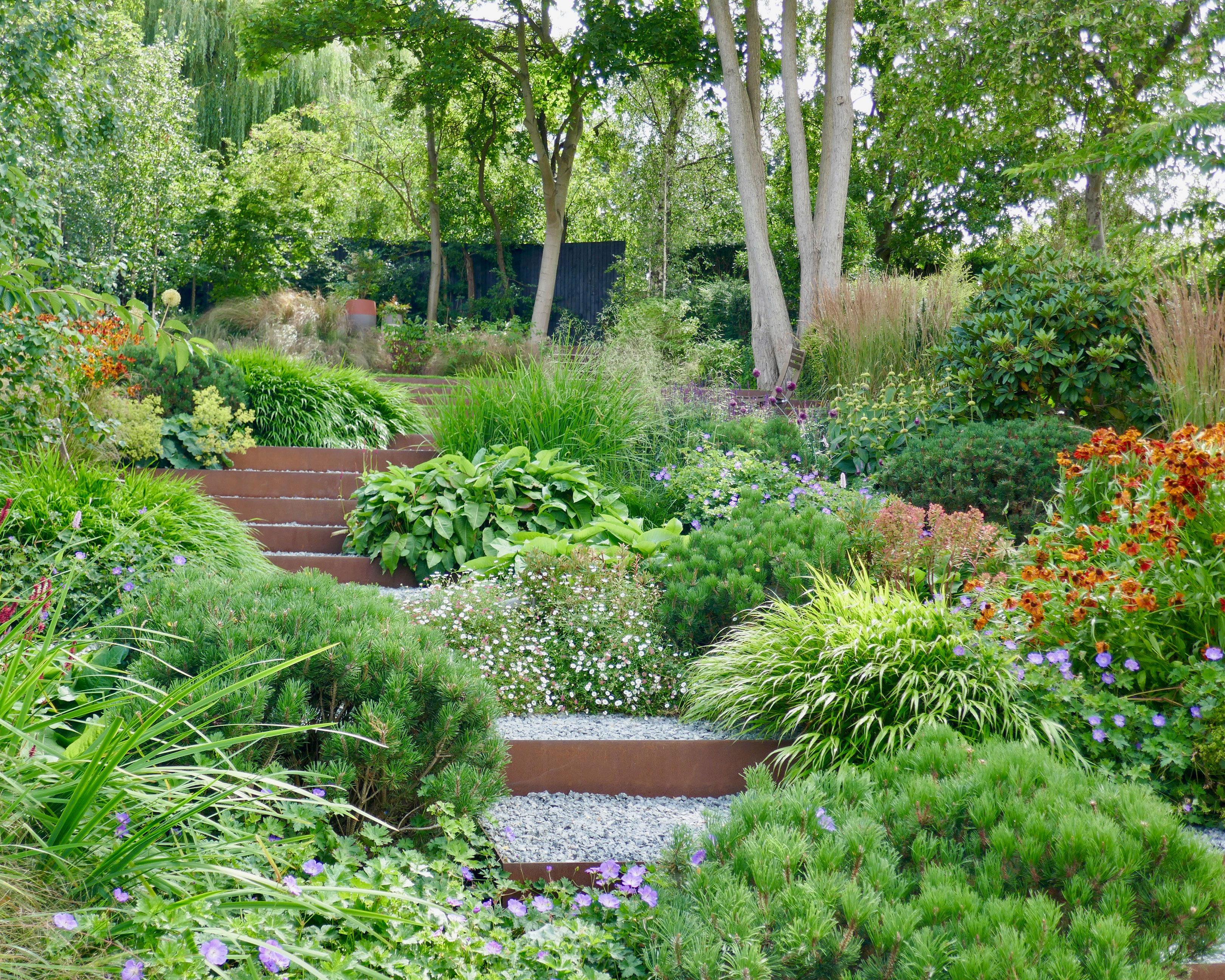
Steps need not be constructed from stone, but could also incorporate other materials.
'We designed this garden (above) with wide gravel and Corten Steel steps. Corten Steel is a very versatile material; it is strong and fairly straightforward to instal. Any joins will be hidden behind the rusty patina that will build up over time and it weathers naturally,' explains Sara Jane Rothwell.
The color of the Corten Steel also complements the surrounding planting. Allowing plants in herbaceous borders to spill over the edges of steps and risers, helps to soften the straight lines.
What do I do with a steep bank in my garden?
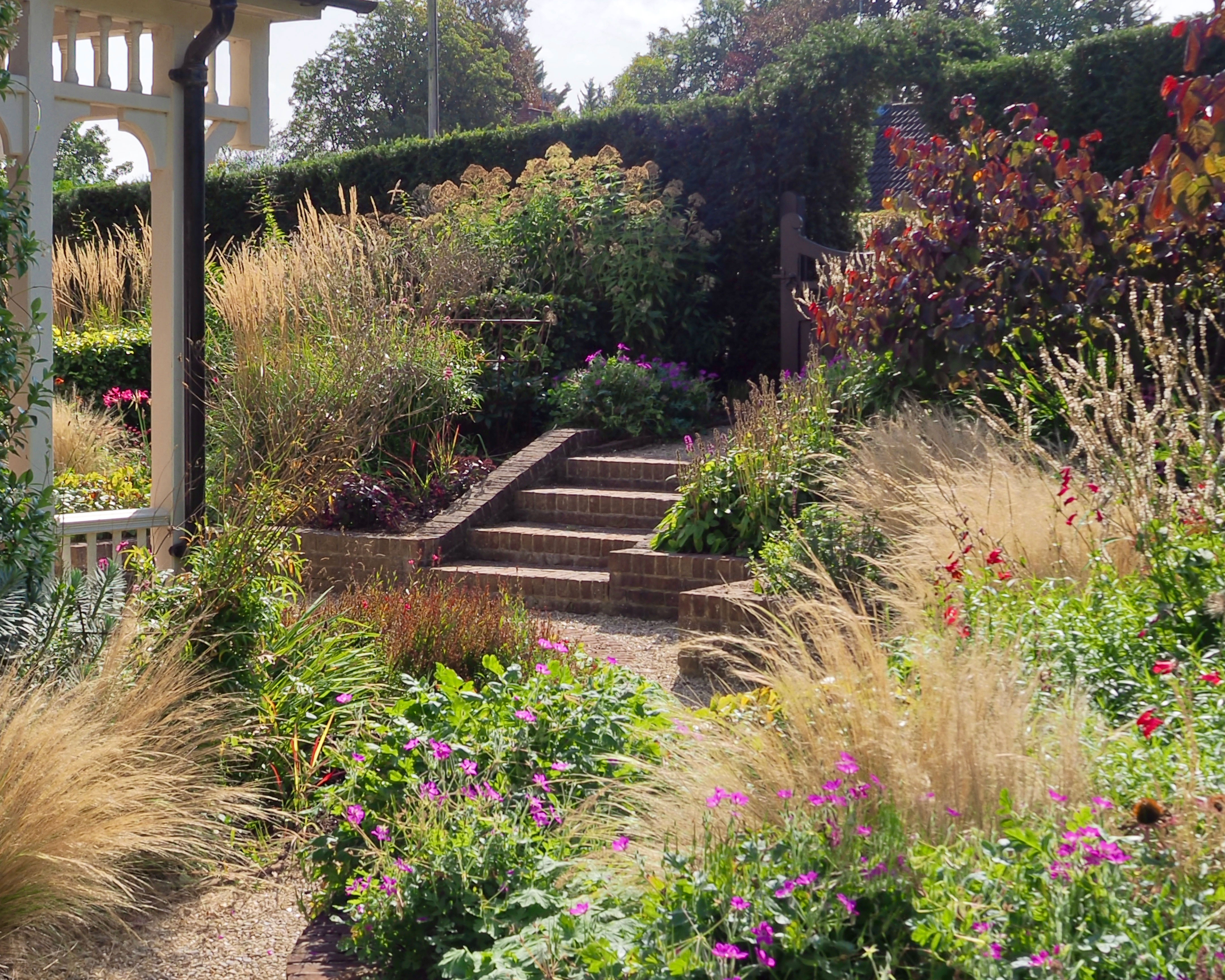
‘Planting up a slope, although a challenge, is a great opportunity to play with perspective,' explains designer Ann-Marie Powell.
'Tall plants are often planted at the back of borders, but plant heights need to be considered in relationship to where you are viewing the border from, as you don’t want to block the border views.'
Successive sweeps of foliage and flowers can build on one another creating multiple perspectives in designs for a sloping garden. Plants of the same height will appear taller as your eye travels up a slope, creating the illusion of layered planting.
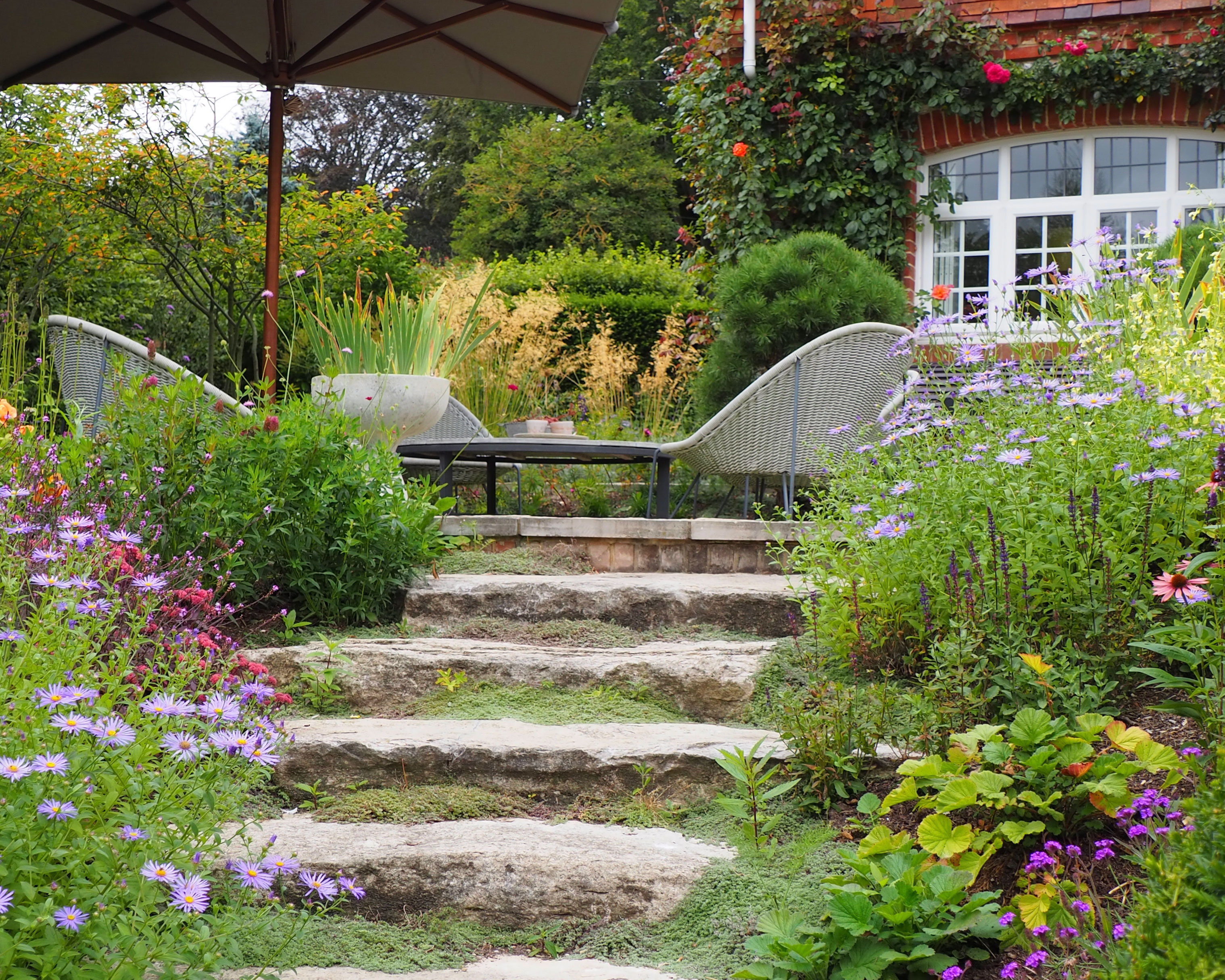
‘Select the right plants which will cope with water run off, as rain naturally travels down a gradient,' adds Ann-Marie Powell.
On a sunny slope, consider plants which will cope with dry soil conditions, such as grasses, verbena, euphorbia, gaura, achillea and others often considered gravel plants, or used for creating a Mediterranean garden.
'When planting, we’ll often use a mini-ditch around the plant, which will collect water and so allow plants a moisture sump to draw from.
'Those plants which enjoy conditions with higher moisture levels can be planted at the bottom of the slope where the gradient is less steep and where there is less chance of soil and nutrients being washed away,’ Ann-Marie adds.
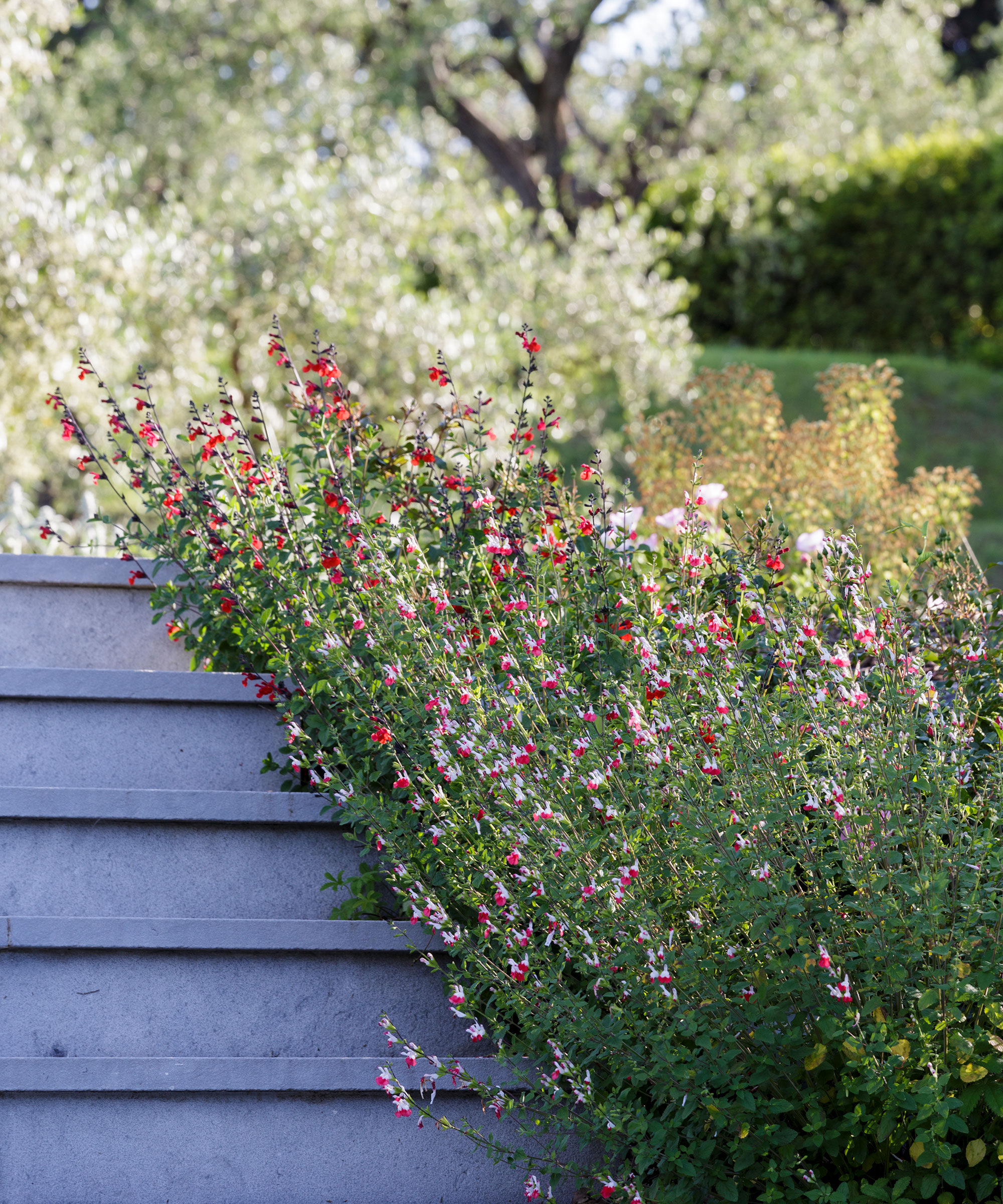
'Certain plants can help with the problem of soil erosion on slopes,' says Ruth Chivers.
'Sloping areas need more plants to cover the ground.' Some useful low growing plants include:
- Acaena
- Bergenia
- Cotoneaster congestus ‘Nanus'
- Cytisus kewensis
- Helianthemum
- Hardy geraniums
'Choose grasses that have a spreading growth habit rather than clump forming – these add a lovely sense of movement in the wind,' adds Ruth.
It is easy to get to grips with growing ornamental grasses and Ruth suggests among good options for a sloping site are Carex divulsa, hakonechloa and the prairie dropseed, Sporobolus heterolepis.
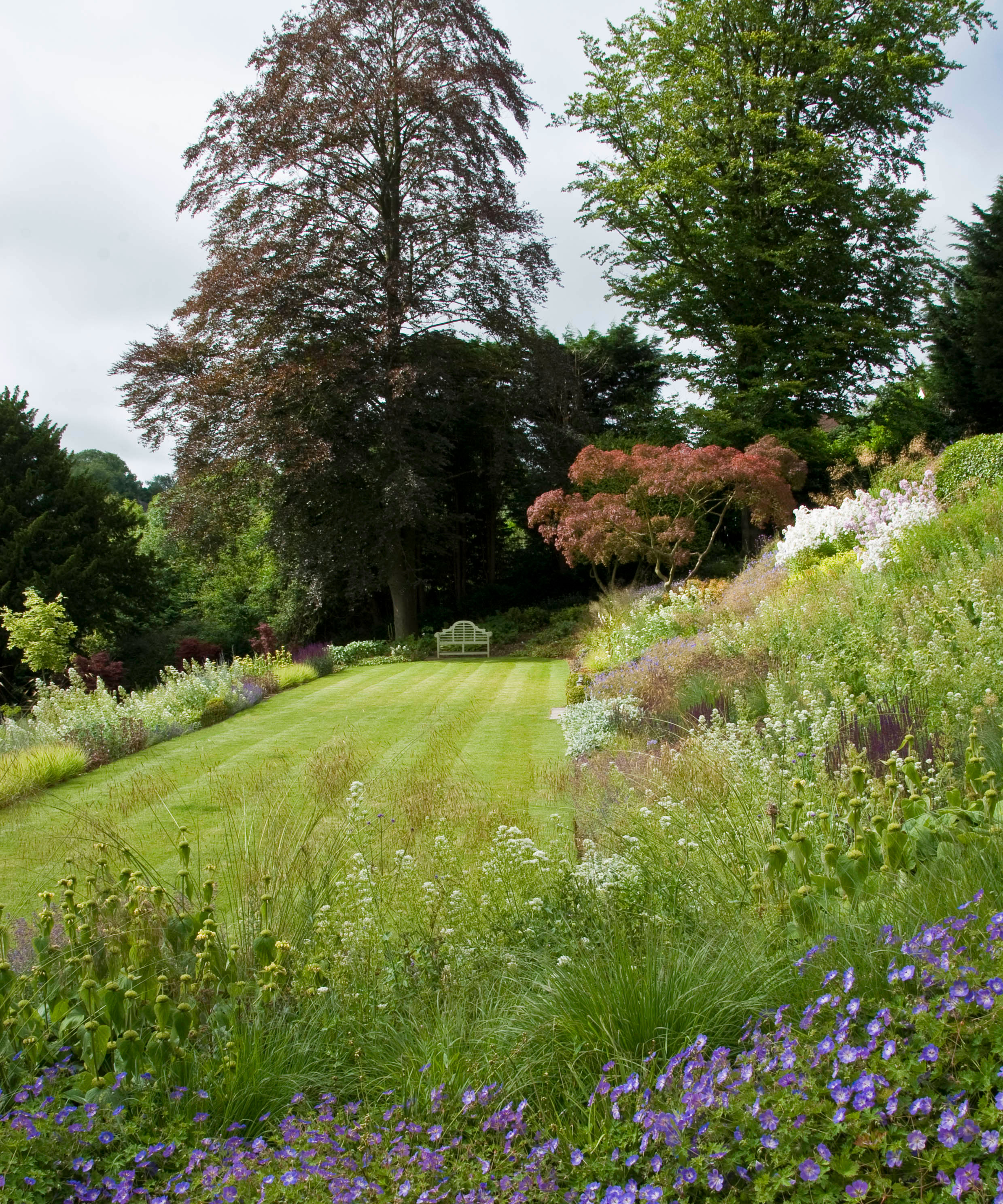
Allow the planting to prevail, and capitalize on the garden slope provided to serve as 'a wonderful theatrical ramped stage to showcase cascading layers of planting,' says Sara Jane Rothwell.
Create soft, undulating rhythm with repeated planting for a restful composition.
Lastly, 'maintenance is also something to consider – a gardener's path through large beds will make it easier for you to weed, feed and cut back when required,' advises Ann-Marie Powell.
When do you need to use retaining walls?
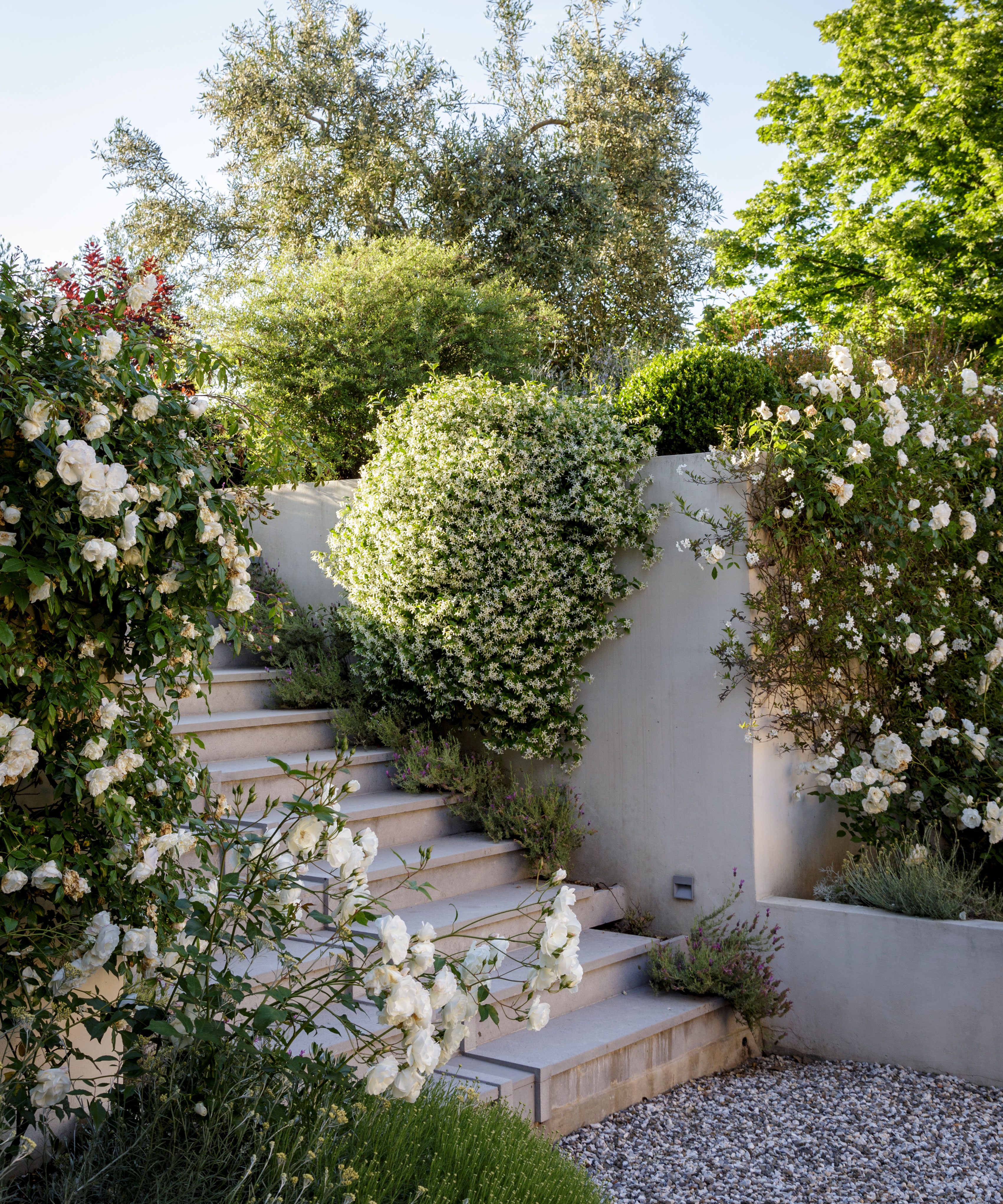
‘Often a key requirement for clients in designs for a sloping garden is the need to have some flat, usable spaces. But remember that you can’t change levels at the boundaries or around existing trees,' explains Debbie Roberts of Acres Wild Landscape and Garden Design.
The ‘cut and fill’ method to dig out and level a slope makes the best use of the soil on site, 'as it is expensive to bring soil in or take it away,’ explains Debbie.
This involves digging out soil to lower the top half of the area, and using the same soil to fill the lower half.
You will then need to consider how to deal with the resultant slopes.
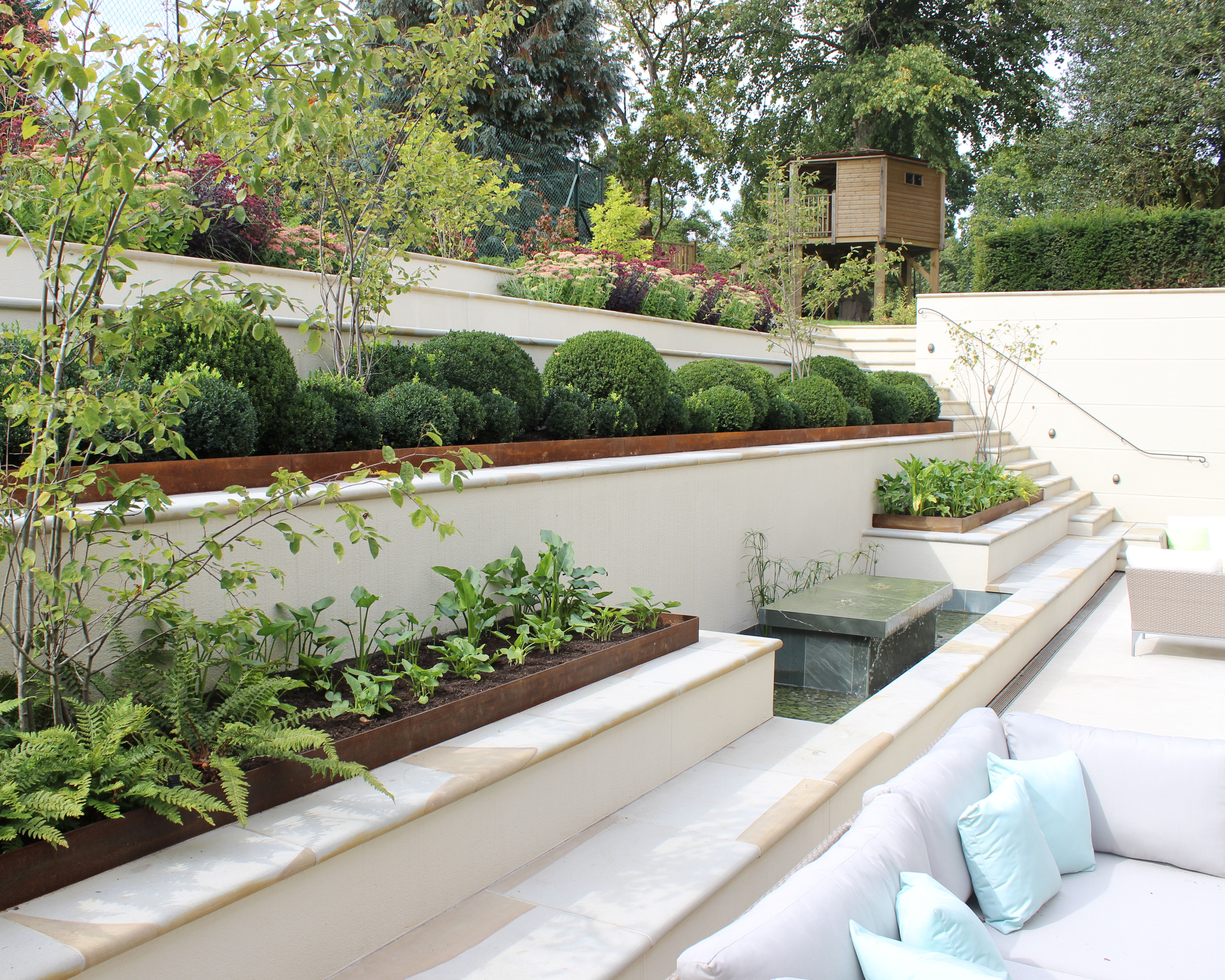
'Retaining walls essentially hold up the rest of the garden, so require heavy reinforcement, to strict calculations, to take the strain,' explains Sara Jane Rothwell.
Due to the expert engineering required, retaining walls are, inevitably, expensive.
'Retaining walls can become a feature in their own right, or be concealed behind planting,' adds Sara Jane.
'Drainage is also key on a steep slope, and a series of underground drains and channels can be incorporated within a design to carry the water away.'
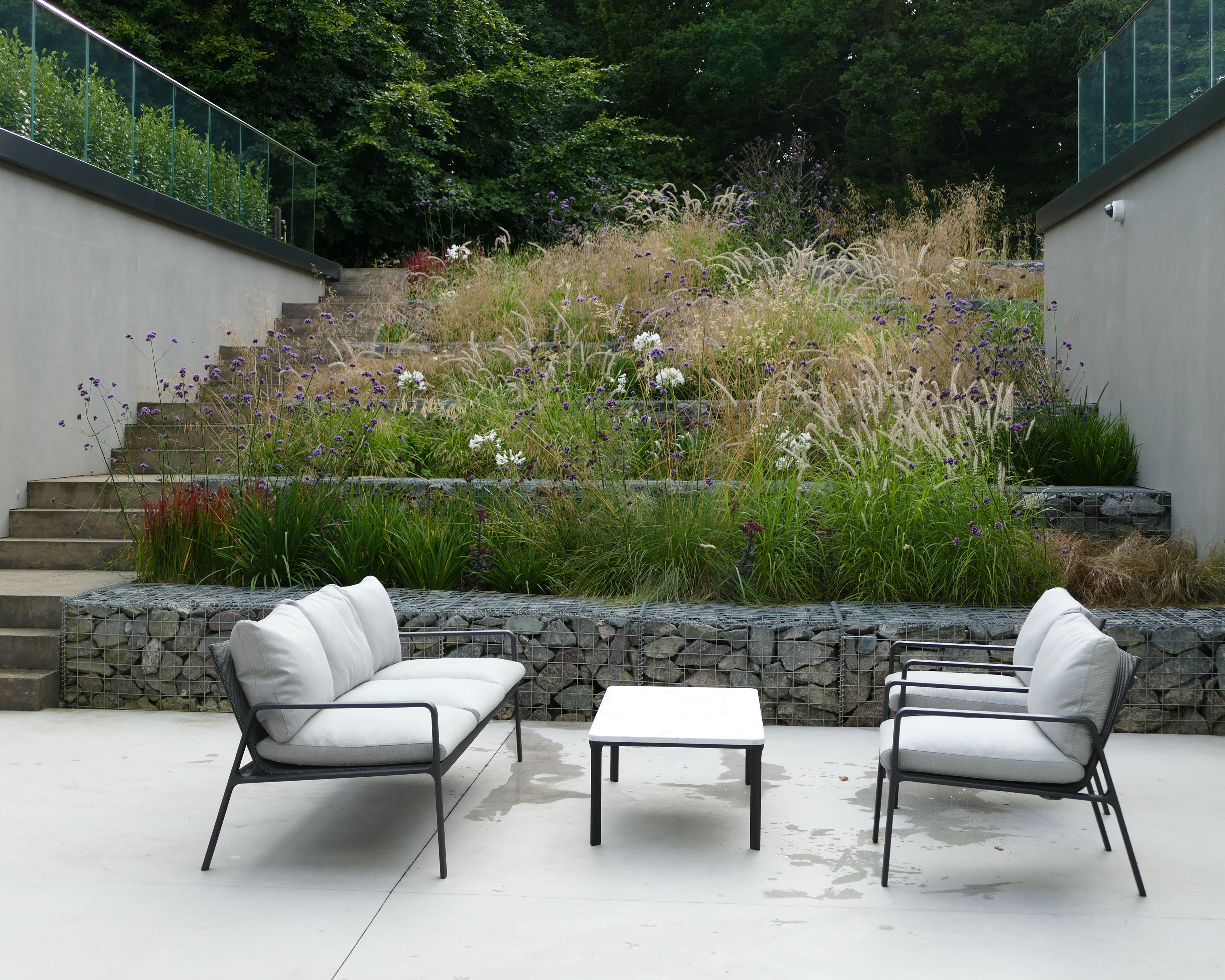
'If retaining walls are necessary, where to place them so their height is not oppressive is really important,' says Ruth Chivers.
You could create a more gradual, terraced effect 'using a combination of low banks and walls, as this will result in a much softer and less "engineered" appearance,’ says Debbie Roberts.
Retaining walls, much like garden wall ideas, can be made from all manner of materials, from wood and stone, to concrete or bricks.
'Stone-filled gabion walls provide structure, as well as an interesting visual pattern, which can be contrasted with layered textural planting,' explains John Wyer.
How do you landscape a steep slope without retaining walls?

'Planting up a slope is a really great, sustainable, low environment-impact opportunity to do away with the hard lines and expense of retaining walls and fill a graded landscape with a plethora of biodiversity enhancing, carbon locking, beautiful plants,' says Ann-Marie Powell.
‘Where a steeper change of level is needed, we generally create banks for planting,’ agrees designer Mandy Buckland of Greencube Landscapes.

'We recently used motorway stabilizing geosynthetics – Terram – this creates pockets for plants once soil has graded back in the stabilizing material,' adds Mandy Buckland.
So do not be deterred by a sloping garden, but use inclines to your advantage and discover the many design opportunities a slope offers.
Sign up to the Homes & Gardens newsletter
Design expertise in your inbox – from inspiring decorating ideas and beautiful celebrity homes to practical gardening advice and shopping round-ups.
Rachel is senior content editor, and writes gardening content for homesandgardens.com, Homes & Gardens magazine, and its sister titles Period Living Magazine and Country Homes & Interiors. She has written for lifestyle magazines for many years, with a particular focus on gardening, historic houses and arts and crafts, but started out her journalism career in BBC radio, where she enjoyed reporting on and writing programme scripts for all manner of stories. Rachel then moved into regional lifestyle magazines, where the topics she wrote about, and people she interviewed, were as varied and eclectic as they were on radio. Always harboring a passion for homes and gardens, she jumped at the opportunity to work on The English Home and The English Garden magazines for a number of years, before joining the Period Living team.
-
 This simple marble hack elevates my budget-friendly wooden kitchen countertops and prevents the dreaded water damage for way less than you’d think
This simple marble hack elevates my budget-friendly wooden kitchen countertops and prevents the dreaded water damage for way less than you’d thinkThis design trick looks expensive, solves a problem, and was the easiest decision I made during my kitchen reno
By Charlotte Olby Published
-
 Emily Blunt gifted Cillian Murphy this $545 pillow – she's 'obsessed' with these luxury pillows, and frankly, so are we
Emily Blunt gifted Cillian Murphy this $545 pillow – she's 'obsessed' with these luxury pillows, and frankly, so are weThe Oppenheimer stars sleep on this ultra-luxe goose down pillow – here's why we love it – plus our affordable alternatives from $35
By Sophie Edwards Published